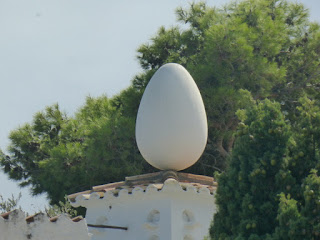The view down,
As a saving grace, there was a former monastery at the top with a bar/restaurant where we could get a coffee. Here we are sitting on the top of the world.
About two thirds of the way up the hill you come across the ruins of the monastery of Sant Llorenc de Sous which was established in the 11th century but continued to expand right to the 13th century.
Before arriving at Figueres, we decided to go further along the coast to visit Cap de Creus which is the most easterly point of the Spanish mainland. It is a place of rugged beauty that at times resembles moonscapes. The odd shaped rocks, barren plateaux and deserted shorelines that litter Dali's famous paintings were not just a product of his fertile imagination. This is the landscape that inspired the artist which he described as a 'grandiose geological delirium'.
On the way to the cape, you come across the delightful village Cadaques where whitewashed houses seem to gleam above the cobalt-blue waters of a rocky bay. It is a very beautiful first glimpse of the village.
Looking across from the cape.
One of the bays.
The terrace bar/restaurant.
Our very own Daliesque photo.
This would have been the view Dali woke up to each morning, gazing out at Port Lliget.















No comments:
Post a Comment